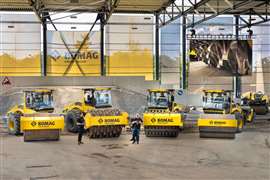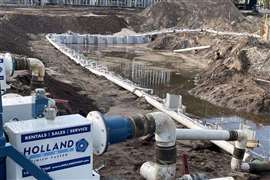Turning heads: Rotating telehandlers
24 August 2021
Beyond productivity, these heavy lifting units with their revolving turret system, are also gaining market share by superseding smaller cranes in urban areas. Access, Lift & Handlers reports.
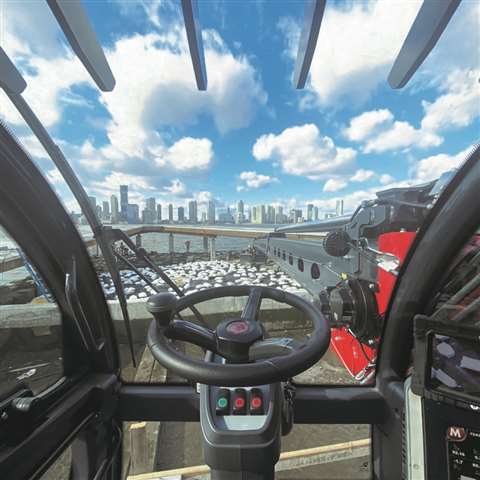 Bird’s eye view of New York City from a Magni telehandler cab
Bird’s eye view of New York City from a Magni telehandler cab
Rotating telehandlers have long been utilized in European construction due to smaller working footprints than the U.S. Yet these versatile machines are rapidly becoming a go-to means for getting work done as more contractors in urban areas realize the benefits rotators offer.
Access, Lift & Handlers spoke with Gary Weisman (Magni Telescopic Handlers), Austin Bailey (AMS-Merlo) and Steve Kiskunas (Manitou) to find a feel for where the market is and what to expect in the future.
How is the current market for rotating telehandlers? Up or down compared to a year ago?
Gary Weisman: Our current market for rotators is excellent. The demand from the dealer community has been strong, and we now have a national network of premium partners covering most any market. This, along with our national marketing efforts, has fueled a strong interest in rotators from contractors. The increases in safety, productivity and cost savings, along with the versatility of having several machines in one, continues to drive the adoption of Magni rotators.
Austin Bailey: We have found the current market to be very, very good. Last year, even with the COVID-19 pandemic affecting many industries, our rotating telehandler sales and rentals did better than expected. We have found that more construction operations have come to realize the versatility of a rotating telehandler on their site translates into better use of time and manpower.
Steve Kiskunas: We project the market will end higher than the previous three years, based on results to the middle of 2021. The market continues to recover from the Covid-19 slow down, and we see the market demand increasing as the overall business outlook continues to improve in 2021.
How do you see the rotating telehandler market shaping up in 2022?
GW: Magni’s growth in 2021 vs. 2020 will be well over 100 percent, and we expect to continue this blistering pace in 2022. Our dealers have experienced excellent growth with Magni and continue to invest in inventory, training and sales efforts. In the coming months Magni will be bringing online a new factory in Italy, which will triple our output worldwide. This will support our continued growth in the United States.
AB: Traditionally, rotos are heavily used in dense urban markets where space that would be needed for crane usage is at a high premium such as Raleigh, Charlotte, Boston, New York, New Jersey, Philadelphia, Atlanta and many of the Florida coast cities. We are also seeing usage growth where space is not a premium in and near the Permian Basin as well as areas in the Gulf Coast.
The list of applications for rotating telehandlers is ever-growing, but some of the more popular ones include new builds of distribution and data centers, hospitals, chemical plants and refineries, apartment complexes and general construction that require a telehandler with a reach beyond the capabilities of say a normal 10,000lb capacity, 56-foot reach machine. Maintenance and upgrades to existing buildings is seeing roto usage growth, also.
SK: Rotating telehandlers currently answer two very specific jobsite needs, material placement in confined areas and material placement above 56-foot heights.
For the first, the rotating telehandler can be placed in one spot. With the rotating feature, unload trucks, stage materials and place those materials on the site without needing to reposition the machine.
For the second, rotating telehandlers can both lift higher and reach further than conventional telescopic handlers. These two features place most rotating telehandlers on urban jobsites, where their efficient operation and greater working range is needed.
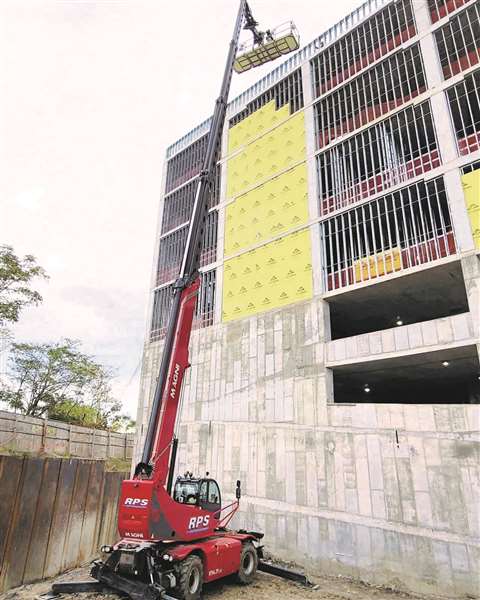 Rotating telehandlers, such as this Magni unit, can be fixed with personnel baskets, transforming them from pick-and-place machines to mobile elvating work platforms.
Rotating telehandlers, such as this Magni unit, can be fixed with personnel baskets, transforming them from pick-and-place machines to mobile elvating work platforms.
What are two of the biggest trends in the rotating telehandler industry?
GW: The biggest trend in the industry is the desire by end users to lift safer, higher and heavier. Magni is the industry leader for all of these.
With industry leading technology including full LMI standard for all machine models, several models with lift heights exceeding 100 feet (topping off at 167 feet) and capacities from 11,000lbs to 28,600lbs, Magni delivers what others cannot.
Training has become a primary focus for Magni. We have invested heavily in creating world-class training for both our dealers and end user customers. This includes the development of an LMS online learning platform and training videos for end users.
Magni recently partnered with the IUOE (International Union of Operating Engineers) and are working with them to develop a rotating telehandler training program at their national training facility.
Magni has raised the bar for rotating telehandlers by replacing several machines with one, which offers the ability to do most of the work that a crane can do without the permits and crane operator, and our enhanced safety features.
AB: The 20-degree tilting cab, as well as the more intuitive safety features on the Merlo line of rotating telehandlers has helped to increase the Roto’s usage across industries. We are seeing contractors designating two to three operators for the machine on the jobsite.
This kind of personnel placement ensures less downtime due to training on the machine, more up time in machine productivity. It also increases the safe operation of the unit on jobsites, as these machines are increasingly being utilized by different sub-contractors with different attachment needs.
Crane replacement is a given on jobs that ask for high lift, but not needing huge capacity, especially when jobsite geography is very tight. On the flip side we are seeing an increase in demand for higher weight capacity machines, which in a number of instances can also replace crane usage.
SK: Rotating telehandlers continue to push into higher material placement heights. As an example, Manitou Group launched the new MRT 3570 unit in April 2021 with 114 foot maximum lifting height.
OSHA [Occupational Safety and Health Administration] regulations when used as cranes with loads over 2,000 pounds. We also are starting to see an impact on the industry in the US of the enforcement of the new OSHA Crane Standard. A certified crane operator may be required for those rotating telehandlers operating with suspended loads over 2,000lbs.
The rotating telehandlers are not designed as cranes. However, the broad definition that OSHA uses for their evaluation places most rotating rough terrain forklifts into the crane regulations when using a hook attachment.
What’s your company’s estimated US market share for rotating telehandlers? Has this increased, decreased or remained the same over the past year?
GW: We estimate that Magni today has an 80% market share for rotating telehandlers in the United States. The increase year on year has been exceptionally strong and continues to grow.
AB: We have held steady at around 30% of the market, but that number has gone up exponentially in the past two years.
SK: As a general rule, Manitou Group does not release data on product market share. However, as the first company to market rotating telehandlers in North America, we do believe our market share is significant and we do see it growing year on year.
We see a lot of heavy lifting applications for rotators, which continue to get bigger. Will there ever be a need for smaller, more compact rotating telehandlers?
AB: The need for compact rotators is small from what we are seeing. There will always be unique jobs that require a machine with less lift height and less operating capacity. Merlo does have Rotos in this category, such as the R50.21 S Plus with a maximum lift height of 69 foot and load capacity of 11,000lbs.
SK: I believe there is a limited opportunity for North America. Europe has an established market for compact-sized rotating telehandlers, but this concept has been slow to transfer to North America. The two barriers we see to greater demand for compact rotating telehandler units in North America are the existing population of standard fixed boom telehandlers and the fact that most jobsites in North America have room for these fixed boom units to operate.
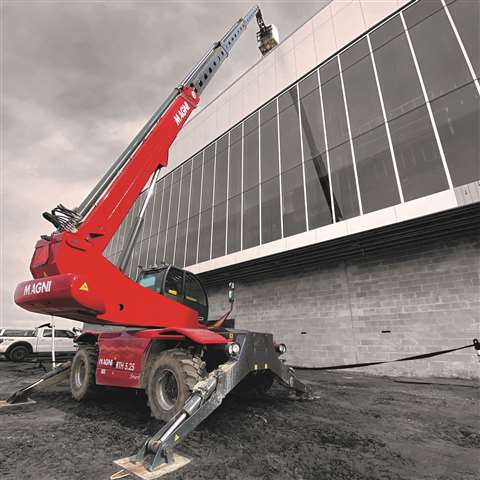 Magni telehandlers being utilized at Orlando International Airport.
Magni telehandlers being utilized at Orlando International Airport.
What machine changes/updates can we expect in the coming years for rotating telehandlers?
GW: We are continually focused on safety and functionality, so you can expect to see enhancements in these areas. There is a move towards sustainable and environmentally friendly rotating telehandlers, which will include electric powered rotators.
Magni already has available a twin-energy hybrid electric power option. In the next year Magni will make the switch to Tier 5 final engines, another step towards more sustainable solutions.
AB: As these machines become more common on jobsites, operator and jobsite safety should also increase. Merlo already has taken these points and run with them. There are tilting cabs, a boom for the operator plus Merlo upgraded to the more intuitive safety system of the ACSC.
And Rotos now have a SMART arm rest and joystick, which reacts to the presence of an operator’s hands in relation to the machine controls.
SK: We expect customers will continue to see machine upgrades as the rotating telehandlers continue to adapt to the needs of contractors using the product. We also expect new and updated attachments to be introduced, as these work tools provide greater efficiency when matching the application and tasks to the right attachments.
With a machine that combines fork material handling with suspended load handling and work platform use, the opportunity for attachments that combine these three functions exist – such as the Manitou work platform with winch attachment.
What is the most-recent rotating telehandler your company debuted? Did this unit fill a gap in your product line, expand your line or replace a model?
GW: Magni recently reintroduced several models with higher lifting capacities. Examples of these include the RTH 6.25 (13,200lb capacity, 82 foot height), RTH 7.26 (15,400lb capacity, 85 foot height) and the RTH 6.51 (13,200lbs of capacity, 167 foot height).
AB: Earlier this year we added the R70.28 SPLUS rotator to our fleet. This unit has it all with a tilting cab, the intuitive ASCS safety system, ergonomic cab with SMART controls, two horizontal joysticks and Merlo’s 360-degree view from the cab.
It is very compact, even with the independent stabilizers fully extended (20ft 7in). What it has done for us is create its own demand with a heavy duty rotator whose maximum operating capacity of 15,400lbs can lift 6,600lbs up to 92 feet.
SK: Our entire line of rotating telehandlers has been redesigned and updated with new operator features, increased capacities and higher lift heights. The new MRT Vision and Vision Plus units replace the past MRT Easy and MRT Privilege Plus units.
What’s next for your company and rotating telehandlers?
GW: Magni is nearing completion on a new factory in Italy, that will triple our capacity worldwide. We expect the market for rotators to continue to grow exponentially, and we are making moves to ensure we stay the market leader. In the United States, to stay ahead of the growing demand, we recently opened a new parts distribution facility in Texas that will allow us to increase our parts inventory by a magnitude of 10.
With human resources being the most important investment we can make, we have added to our team a National Service Training Manager, a National Parts Manager, and several key staff at both of our facilities in the United States.
AB: We are looking forward to gaining more market share over the next 12 to 24 months. Merlo’s engineers will do what they do best, continue to improve upon their Roto design to not only meet current market demands but be ahead of what the market may need in the future.
SK: Our brand new Vision and Vision Plus rotating telehandlers will include a number of industry firsts – one innovation is a falling object protection structure that is clear for 100% unobstructed vision.
The MRT Vision Plus range of rotating telescopic handlers will replace the MRT Privilege Plus range, with the availability of more powerful models in terms of capacity, visibility and comfort. The MRT Vision Plus telehandlers are ideal for all industrial and construction applications.
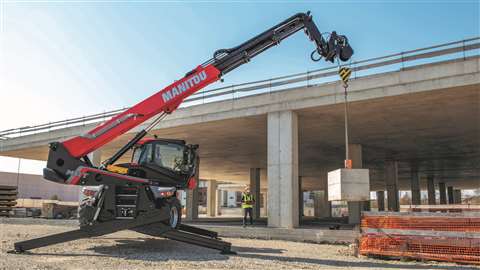 The Manitou MRT 2260 telehandler.
The Manitou MRT 2260 telehandler.
STAY CONNECTED



Receive the information you need when you need it through our world-leading magazines, newsletters and daily briefings.
CONNECT WITH THE TEAM










